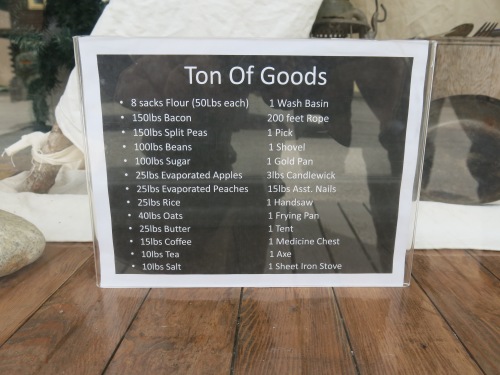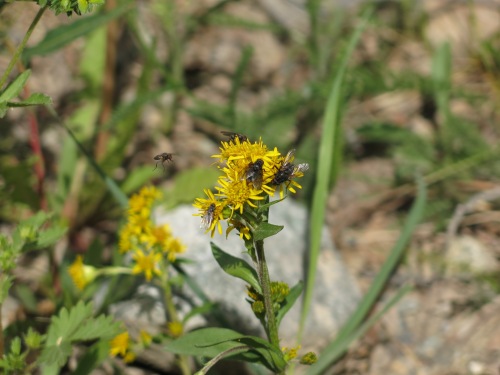In the past few years I have been hearing a great deal about the insect research that is going on in the Arctic (mostly from the NBP project run at McGill University) so when the opportunity came for me to go up myself I couldn’t say no. I am fortunate to be spending two weeks on the Dempster Highway in the Yukon this summer. I’m here for two reasons, to look for leaf miners in goldenrods for my current research and to assist in collecting flies for taxonomic and evolutionary ecological projects. The following is a little about my own Yukon Gold Rush some 118 years after the real gold rush; the search for goldenrods of the Yukon.
First a little background about recognizing the species: There are three species of goldenrod in the Yukon, Solidago canadensis, Solidago multiradiata and Solidago simplex. Solidago canadensis, the Canada goldenrod, is a very widespread species covering most of North America and is even becoming invasive in Europe. It’s a species that most people mistaken for ragweed; they’re found in ditches, roadsides, and disturbed areas and in old-field habitats. They are generally tall with bright yellow flower heads composed of many flowers. Solidago multiradiata (northern goldenrod) and Solidago simplex (dune goldenrod) are evolutionarily closely related and look very much alike; they tend to be small with most of the leaves at the base, getting smaller as you move up and the flower heads tend to look like spikes sticking straight up into the air. The main difference between these two species is the pubescence; the northern goldenrod is very hairy around the flowers and the upper stem whereas the dune goldenrod is not hairy.
I wasn’t sure whether I was going to find an of the known goldenrods in the Yukon and if I did I wanted to know whether their leaves were getting mined and by what. So I prepared myself and brought some rearing vials along just in case.
We arrived to Whitehorse and spent the new few days around the area. To my delight I found goldenrods on the second day by Miles Canyon, It was both the dune and northern goldenrods (Pic 1). But alas, no mines. I was 2/3 of the way to riches with goldenrod identification but no success with finding leaf miners. I found more northern and dune goldenrods on the shores of Fish Lake outside of Whitehorse being overrun by pollinating flies (Pic 2) and then I just saw them everywhere, especially on the roadsides and rocky slopes.
We went for a day to Skagway and I was happy that my goldenrod rush did not involve all the gear the gold rush stampeders had to bring; a ton of goods! Everything they needed to survive and they had to carry it on their backs across the Chilkoot trail to Dawson city (Pic 3).

Pic 3: What Stampeders had to have with them to make the trek to the Yukon for the 1897 Gold Rush. List in window of Skagway information center.
I almost had to wait to get to Dawson city to find the last of the three goldenrods, the Canada goldenrod. I found a little patch at Stewart Crossing, not mined though. But before then I found mined Dune goldenrod at Two Lakes Campground on the Alaska highway. I continued to have success finding leaf miners on Dune goldenrods; I collected two species of leaf miners from Solidago simplex by the Dawson city airport and at Midnight Dome just outside Dawson. So I guess I struck gold in Dawson City!
We also went up the Dempster highway and I kept finding un-mined Dune goldenrod along the roadside until about 20km into the road. As the name suggests the Northern goldenrod is the most northerly goldenrod and I kept finding it up the Dempster although it is very patchy distribution; I found small un-mined plants in the rocky areas by the Tombstone valley lookout and on the trail to Goldensides Mountain, which I think is a great place to find goldenrods (Pic 4): Goldenrods on Goldensides! I did find both the dune and northern goldenrods further North. I identified dune goldenrods in a rocky pull out by the Blackstone river crossing and northern goldenrods at another pullout with outhouses on the shores of the Blackstone river. Both of the species were mined and the mined leaves are now in my rearing vials so I’ll be able to find out what they’re mined by so far in the North.

Pic 4: Solidago multiradiata, northern goldenrod, on the slope of Goldensides mountain, Tombstone Territorial Park, Yukon.
Overall the Yukon is a wondrous place for anybody that is a naturalist or enjoys nature. If you’re out here keep an eye out for goldenrods and the huge diversity of plants and insects. But please don’t pick the plants without permission from the Yukon Government and the First Nations.
Acknowlegments: I would like to thank Terry A. Wheeler for suggesting the title for this post.


